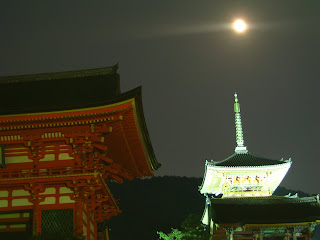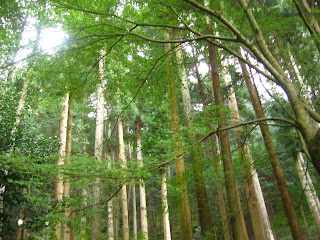
We knew that we would be leaving Japan soon. It seemed that the smart thing to do would be to travel more and see as much as we could before we left. Paola suggested that we head to Mt. Fuji and see what there was to see there.
We woke up early, so that we could catch the first bus. We woke up at 5, and then took the train to Shinjuku, which took about an hour. We didn’t know where the bus stop was, so we walked around for a while looking for it. The bus fare was less expensive than we expected, so that was good. The bus took about 2 hours, and we were able to see the mountain pretty much the whole way from the window of the bus.
When we got there, we felt like we were basically at the foot of the mountain. However, we were actually about another hour from the base of the mountain from where people might begin hiking up the mountain. We were able to get a great view of the mountain from the bus station, but there were the ever-present power lines that blocked what would otherwise be a perfect view.
To get the perfect view, we walked to a hill that had an observation deck. At the bottom of the hill, we paid to take a cable car up to the top of the hill where the observation area was. It was a great view, and there weren’t that many people to contend with.
Once we were finished with that viewing, I wasn’t quite sure what else there was to do. Paola suggested that we go see another temple. The guide book led her to believe that it was a mere fifteen minute walk. It took us at least an hour to walk there. She was not in a good mood at all, and even though the temple was neat to see within the forest at the base of the mountain, it was rather uneventful.
Paola next wanted to see a cave that was nearby because she is fascinated with caves. We ended up having to take a taxi for about twenty minutes to the cave. The price of the taxi ride was very high, and this made Paola that much more upset. It made sense, though, if one were to look at the map, that this place was far away, and the taxi ride would be expensive.
The cave was an ice cave that was formed in prehistoric times by the lava flow of Mt. Fuji. Within the cave, ice occurred naturally, and so it was called the ice cave. Walking through the cave was fun. The floor was slippery, and the ceiling low. I didn’t slip, but I did hit my head a couple of times. At one point, we had to crawl through a short tunnel. As fun as it was, walking through the cave took less than fifteen minutes. Because we paid so much for the cab ride, it didn’t seem worth it.
After we left, we decided to wait for the bus rather than pay more for a taxi. When we got to the bus stop, the schedule said that we would have to wait an hour and a half for the next bus. It was worth it to wait. We waited. And waited. After two hours, the bus never came. Perhaps we misread the bus schedule (it was in Japanese, after all). We walked back up to the office of the ice cave, and called a taxi from there, so we had to wait for two hours to pay for the taxi. It seemed like a huge waste of time. To make matters worse, when we got to the bus station, we tried to buy a bus ticket home, but the next available bus was a two hour wait. So, although seeing the mountain, temple, and the ice cave was neat, we wasted a lot of time and money, and that took away from the joy of the whole experience.



 Praying Jizu
Praying Jizu Temple
Temple Rock Garden
Rock Garden Golden Pavilion up close
Golden Pavilion up close Golden Pavilion
Golden Pavilion Ryoanji Rock Garden
Ryoanji Rock Garden Buddha at Ryoanji
Buddha at Ryoanji Shrine gate
Shrine gate
 roof tiles
roof tiles Myoshin-ji Buddha
Myoshin-ji Buddha George, as a relaxing samurai
George, as a relaxing samurai
 Kiomizu-Dera
Kiomizu-Dera Paola and George
Paola and George Kiomizu-Dera pagoda with moon
Kiomizu-Dera pagoda with moon Ryozen Kannon Buddha 1
Ryozen Kannon Buddha 1 Ryozen Kannon Buddha 2
Ryozen Kannon Buddha 2 Philosopher's Walk
Philosopher's Walk George and Paola
George and Paola Temple
Temple Rock Garden
Rock Garden Silver Pavilion
Silver Pavilion Forest
Forest

 Nijo Castle 1
Nijo Castle 1 Nijo Castle 2
Nijo Castle 2 Tea House
Tea House Chrysanthemum
Chrysanthemum












 Toji Temple Buddhas
Toji Temple Buddhas Toji Temple
Toji Temple Toji Pagoda
Toji Pagoda